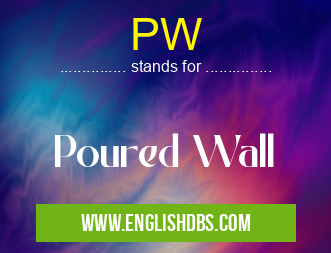What does PW mean in CONSTRUCTION
PW stands for Poured Wall. This type of wall is created by pouring concrete into a formwork. It is also known as concrete walls, cast-in-place walls, and poured concrete walls. Generally, poured wall systems are preferred over traditional block or panelized building systems for their durability and strength

PW meaning in Construction in Miscellaneous
PW mostly used in an acronym Construction in Category Miscellaneous that means Poured Wall
Shorthand: PW,
Full Form: Poured Wall
For more information of "Poured Wall", see the section below.
Essential Questions and Answers on Poured Wall in "MISCELLANEOUS»CONSTRUCTION"
What materials are used to build poured walls?
The construction of poured walls is done with the use of concrete, often reinforced with steel rebar rods. In some cases, a watertight membrane may be used to protect against moisture damage
What structures commonly utilize poured walls?
Poured walls are regularly seen in commercial buildings, such as warehouses and office spaces. They are also frequently used in residential settings as retaining walls and foundation elements
Is there any maintenance required for a poured wall?
As long as the wall was built properly and according to code standards, there should not be much maintenance required for a poured wall system. However, it is always important to inspect a structure regularly to check for signs of wear or deterioration
How does the installation process of a poured wall work?
The pour usually starts with setting up the formwork for the desired shape or profile. Once it is ready and thoroughly checked, reinforcing steel bars can then be added followed by sufficient compaction of the soil on which the concrete will rest on. Finally, after ensuring that everything is set up correctly, concrete can then be poured into the forms.
Are there any benefits to utilizing a poured wall system?
Yes! Poured walls offer several benefits over traditional block or panelized building systems including improved insulation value due to fewer cold joints between blocks; increased strength; fewer call-backs due to cracking; greater flexibility in layout design; and lower labor costs when compared to similar products
PW also stands for: |
|
| All stands for PW |
